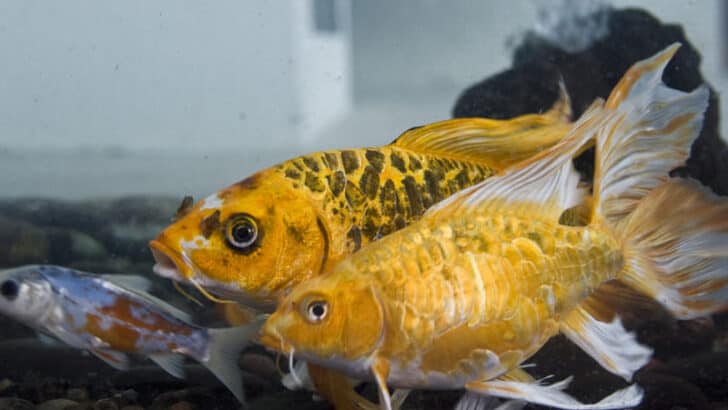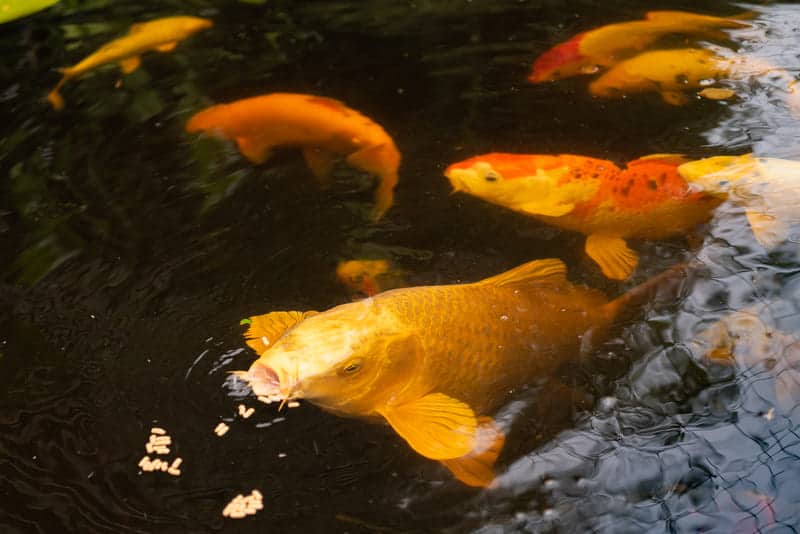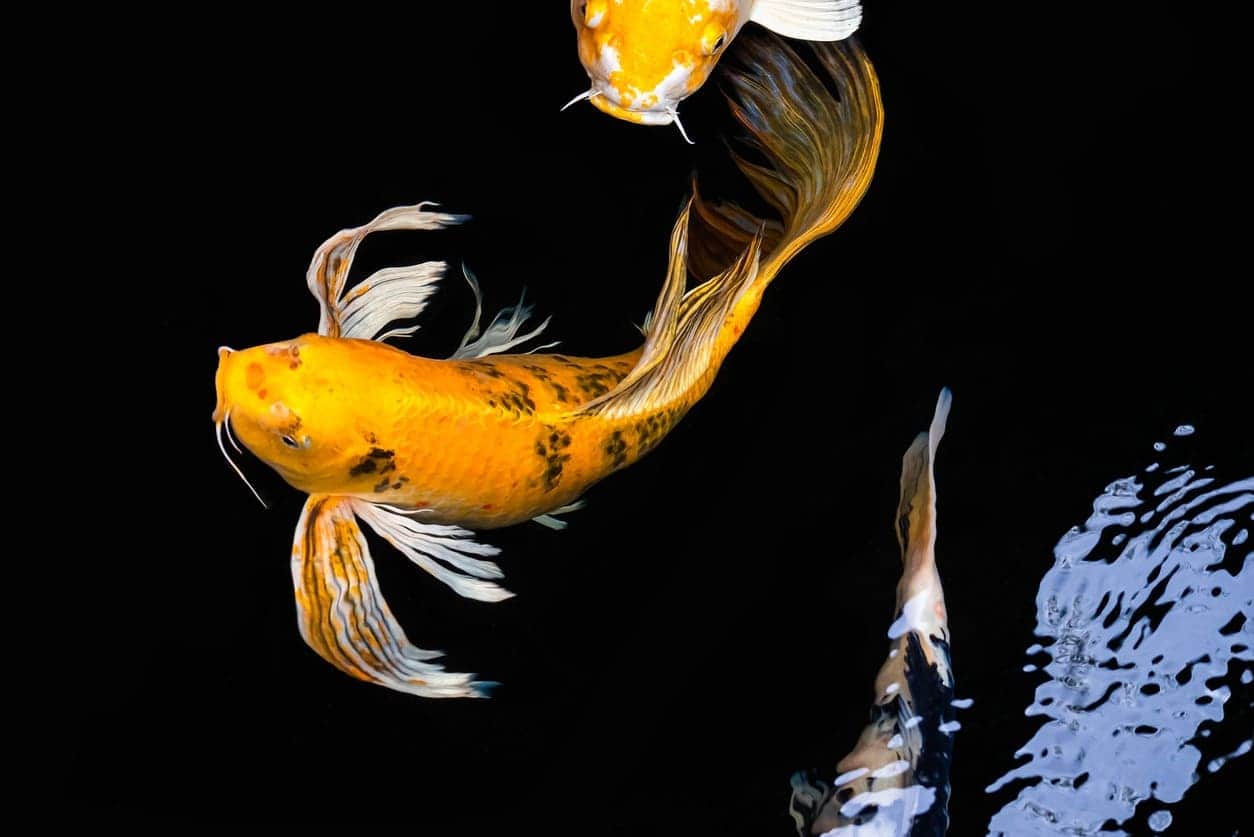A question that a lot of koi fish owners and enthusiasts wonder is what temperatures koi fish can survive in. The general image of this elegant goldfish is of it swimming outside in a garden pond throughout all four seasons and bad or good weather. This makes people wonder – what temperature of the water can koi fish survive in?
Summers in a pond sounds like bliss, but as seasons get colder, and lakes start freezing, you might want to think of bringing your koi fish inside, or doing something for pond water to remain constant.
This article shall let you know all about the required living conditions, temperature, and what you need to do to keep them alive. Read on to know more!
What Should Be Koi Water Temperature During Feeding?
The perfect temperature for feeding koi fish is anywhere between 68 and 86 degrees Fahrenheit as they are the most active around that time.
A rule of thumb to follow, however, is to not feed them one hour after sunrise or sunset. However, with seasonal change, how much you feed koi in a day also changes.
If the temperature drops below 50 degrees Fahrenheit during winter, then it is time to stop feeding your koi and do so only once or twice a week.
This is because their bodies get affected by winter and eventually slow down as they reach the hibernation stage and it is hard for them to digest the food they eat.
Also check: What Do Koi Fish Eat?
Extra food that is leftover from regular feeding can cause the pond to become dirty as your koi will certainly not eat. To help you understand how to feed according to this phenomenon, here is a feeding chart.
| Temperature | Feeding Amount |
| 86°F or higher | 2 times a day, 4 times for smaller koi |
| 68°F – 86°F | 2 – 4 times daily or more times with smaller amounts |
| 59°F – 68°F | 1 – 2 times daily |
| 50°F – 59°F | Only 2 times a day |
| 41°F – 50°F | 2 – 3 times a week |
| Below 41°F | No feeding |
As another general rule, remember that feeding less but daily is always better than feeding more. Under human care, fish can’t die of hunger unless due to extreme neglect. Hence, do not worry about your fish eating enough, and avoid overfeeding so that your pond is kept clean.
What Temperature Is Too Cold For Koi?
Koi fish are cold-blooded by nature, so it is not difficult for them to survive through winter. They also hibernate during this time, so most of them will survive extremely cold weather.
Koi can survive at temperatures as low as 4 degrees Celsius (39°F), after which their body may start reacting to the freezing conditions outside.
As the water starts dropping temperatures during winter, it is essential to keep a pond thermometer to look over the well-being of your koi.
Cold weather slows down the immunity of koi and at around 50°F, their bodies usually run on the pond bacteria known as Aeromonas and can thrive.
Remember that after the temperature drops down to 50°F, you need to stop feeding your koi, because their metabolism is slow during cold weather. Hence, they do not require much food to survive, and you can go by feeding them just once or twice a week.
Surviving in the cold can be hard, so it is important that you also keep your pond winter-ready.
Following are a few things you can do to keep your koi fish healthy throughout winter.
Regular Cleaning Of The Pond
Warmer temperatures create algae quicker, but cold from the winter kills a lot of living matter in the pond. Make sure to thoroughly clean your pond at least once a week, and remove any kinds of debris or dead matter so that it does not turn into harmful waste.
Cleaning need not be thorough – if you simply use a net skimmer to pick up the loose leaves and waste, you can prevent a lot of bad bacteria from mixing into the water.
Heat Installation
Though installing a heater in your pond is not absolutely necessary, it is a great way to make winter bearable for your koi fish and a lot of owners go for it.
One important factor for the survival of fish in winter is making sure that its water body is always aerated and getting enough oxygen to process.
Winter makes aeration hard as the pond surface usually ends up freezing and forming a layer of ice that becomes a blockage. You simply need to break it every time it forms and your koi fish will be able to survive mostly. If you live in an area that is almost always cold, then you should consider getting a heater for your koi’s comfort.
Make Sure Water Is Not Always Stagnant
A lot of people choose to remove or stop the water during colder months to prevent damage. However, this causes the water to remain stagnant, and you will need to find some other way to make sure the water is always somehow moving and going through oxidation and other natural processes.
Regular Maintenance
Make sure to keep up with the winter maintenance – checking the water filter and functioning of the pump, breaking the thin layer of ice whenever it forms, feeding koi fish just the right amount, and cleaning the pond regularly.
It may not be possible to bring your koi inside during this season, and they may also not like the sudden confinement, but letting them grow naturally in the habitat they prefer is the best option you can go for.
What Temperature Is Too Hot For Koi?
Like all other fish, hot weather is not the most appropriate for the good health of your koi. Not only does it cause your fish stress, but it can also cause deoxygenation and algae to grow over time.
Considering the temperature that koi fish like to live in, if the temperature reaches 80 degrees Fahrenheit, it can be uncomfortable for your pets.
Even plants can start to wither if your pond ever starts getting that warm. Your fish will try to swim up to the surface of the water to try and breathe in more oxygen.
If conditions get too hot, then the chances of your fish becoming infected by growing bacteria also rise as hot temperatures make them multiply faster.
Trying to make the environment more natural like adding water lilies or a waterfall to your pond shade and constant circulation for best conditions. If your pond gets too warm for your koi fish, the following are a few ways in which you can better their habitat.
Frequent Water Changes
Warm water can be regulated by adding cooler water from nearby taps or underground pumps. However, since it also needs to be clean, make sure to change only up to 20% of the water. An exceeded amount may be damaging to the water system of the pond and should be dechlorinated before use.
Keep Water Circulation Going
Both warm and cold stagnant water is not good for the survival of your koi fish as y can cause problems like the growth of harmful bacteria.
Hence, you need to always have some kind of circulation going in the pond by a filter or a pump. An average 3,000 gallon/hour pump would also work well for a small-sized pond.
Other affordable options are large-sized filters or a decorative waterfall or stream that can keep the water going.
Adding A Permanent Shade
Keeping the pond covered prevents a lot of dirt and debris from falling and turning into algae over time. You can add any available shade in the market to shield your koi from extreme weather conditions and maintain a more balanced temperature that koi requires.
A natural cover can also be built by using flowers like water hyacinths and lilies as they provide shade and oxygen for the pond. Plants also increase nitrate intake, which further prevents the formation of algae.
Can Koi Fish Live In Hot Weather?
Koi fish are cold-blooded by nature and even if conditions may get warm, they can survive at a temperature of about 90 Degrees Fahrenheit.
They may be able to tolerate such a heated environment, but they do not feel comfortable in warmer conditions and are at risk of death at even 85 Degrees Fahrenheit.
Such warm weather can also cause nitrite and ammonia poisoning in pond fish, as algae and bacteria thrive in humid conditions. Apart from that, koi require sunlight exposure for their healthy growth.
The ideal amount of time for sunbathing is about 6 hours a day for the maintenance of their appearance and health.
What Is The Best Temperature For Koi Growth?
The ideal temperature for koi survival and growth is around 59 and 77 degrees Fahrenheit. Ponds with a lot of deep spaces are great for the distribution and maintenance of temperature as it is one of the most important factors. This is because the metabolism of their bodies changes according to the heat and cold of the water.
In winter, most koi fish hibernate, so their immune system and metabolism become slower and their activities also decrease. You will notice that your fish tend to sink to the bottom and spend most of their time there during cold months. Most fish enthusiasts recommend having a pond at least 2 feet deep.
On the other hand, koi fish grow during summers directly due to sunlight exposure. It is a known fact that koi fish can grow up to huge sizes and weigh up to 91 pounds.
Due to their reputation as giant and elegant fish, a lot of fish breeders in the US use artificial lights during winter to make these fish grow throughout the year.
This causes bigger fishes, but with short lifespans. On the other hand, Japanese breeders prefer to raise koi naturally as they prefer quality.
What Should Be The Temperature Of Koi Pond In Winter?
There is no particular temperature that a koi pond should be in winter, as in the wild, there are no extra systems that can prevent them from the harsh cold. Koi need a temperature between 59 and 77 degrees Fahrenheit to survive, as they generally prefer warmer climates.
The common reason behind fish death in winter is not the cold, but actually, the lack of oxygen from water surfaces freezing.
Hence, you simply need to make sure that your pond does not freeze up and that the filter keeps running. You can also cover your pond if required, but remember to keep some space for air passage.
If your pond is not more than 4 feet, then you should cover it for certain, as it can freeze faster. Ponds even smaller than that can get an aquarium heater as it is more likely to form ice more often.
Many koi owners also prefer installing heaters in their ponds so that their fish can grow throughout the colder seasons. Breeders often go for artificial sunlight, but that decreases their lifespans, so it is not recommended.
Related Questions
What Is The Best Water Temperature For Koi Fish?
Koi fish usually prefer warmer temperatures, and you would not want the bottom of your pond to get too cold. The best temperature, however, is anything between 59 and 77 degrees Fahrenheit.
How Hot Is Too Hot For Koi?
Koi fish do not do well with extreme temperatures, though they are hardy and can survive at a temperature of around 80 degrees Fahrenheit. Anything above that would cause the koi stress or discomfort and can bring other difficulties.
Do Koi Fish Need Heater?
Koi fish do not need a heater, as they can survive minus temperatures, and being pond fish, they hibernate during winter. However, it is recommended to install one as extremely low temperatures put your koi at risk of disease.
Do I Need To Put A Heater In My Koi Pond?
Although it is not necessary to install a heater in your pond, as koi fish can thrive in very extreme temperatures as well, they certainly do not like the cold. Hence, if you can afford to put a heater in your koi pond, it is recommended.
Final Thoughts
Though koi fish are a fancy species, they do not require much pampering to thrive, which is what makes this elegant fish even better to keep at home.
Do keep in mind that although koi fish can live in tanks, they grow the most healthily when they have enough space to grow. So when summer comes, it is better to let your fish out again!



